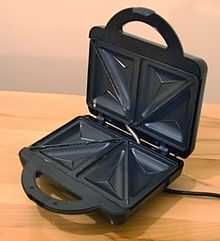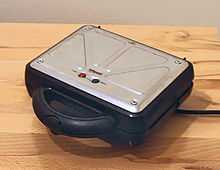Sandwich toaster


A sandwich toaster, also known as a toastie maker, is used to make toasted sandwiches. It can be either a cooking utensil designed to be used over hot coals, or an electrical appliance.
The traditional device is known as a pie iron, pudgy pie iron or jaffle iron. It consists of two hinged concave, round or square metal, plates on long handles. The plates clamp together to form an enclosed compartment meant for cooking stuffed sandwiches. The plates seal the outside edges of the bread together, to completely enclose the filling. They are typically made of cast iron to cook over coal or open flames. Stove top units are also available, made of aluminium and sometimes coated with a non-stick surface.
The electrical version is known by many names, including toasted sandwich maker, snackwich maker'[1] or jaffle maker in Australia and South Africa, although in the latter they are also called Snackwiches, after a once popular brand, and toastie maker in the United Kingdom. They were invented by a Belgian company, and commercialised by John O'Brien of Breville in the 1970s.[2] The name Breville is still used eponymously to describe both a toasted, sealed sandwich, and the device used to cook them.[3]
Typical toasted sandwiches are a grilled cheese sandwich, tuna melt or patty melt. Toasted sandwiches are also known by various names. They are frequently called toasties in the UK and New Zealand, jaffles and toasties in Australia (also brevilles in South Africa) or tosti in the Netherlands. Sandwich toasters are less common in the United States where grilled cheese sandwiches are more popular.
Sandwich toasters are notorious for being used relatively little, because of their specialised nature. A survey carried out in 2005 suggested that 45% of British adults owned but did not use sandwich toasters.[4][5]
Design
Electrical units generally consist of indented hot plates, clamped together around the sandwich similar in design to a waffle iron. Usually two sandwiches can be toasted at a time. The plates are heated by electrical coils inside the appliance. Usually the exterior is somewhat separate from the coils to ensure the outside of the unit does not get too hot. The plates often clamp tightly around the edge of the sandwich, sealing in the filling. The use of a special sandwich toaster seals the edges of the sandwich and may place a diagonal line across it, preventing the filling from spilling out.
Preparation

The toasted sandwich maker presses the edges of the sandwich together to form a seal during toasting. The filling ends up in a cavity within the bread, making the sandwich convenient to eat, but also rendering the filling extremely hot.
Another type of toasted sandwich is the panini. Panini, which translates to "little breads" in Italian, are sandwiches that are pressed during grilling with a Panini-press sandwich toaster. Panini-presses often produce distinctive parallel grill marks on the sandwich and are able to accommodate sections of bread of varying length, unlike other hinged sandwich toasters which require a standard size of sliced bread.
An alternative preparation method uses a toaster oven, where the sandwich is often arranged open face and then toasted. This not only toasts the bread, but also warms the meat or other filling of the sandwich. In particular, toasting causes cheese to melt, making it a popular topping for toasted sandwiches. In many restaurants, sandwiches are toasted in large conveyor belt style toaster ovens, such as at Quizno's, Subway and Boston Market.
Perhaps the most commonly used filling is cheese, on its own or together with tomato or ham. Pickles, and sweet toppings such as jam, banana, or chocolate spread are other examples. It is also common to use pre-prepared savoury fillings as well, such as baked beans, tinned spaghetti or tinned casserole varieties.
Industrial units range from those similar to the kitchen appliance, squashing or clamping the sandwich, to grilling units, which use dry heat to toast the bread. Panini are often made using equipment similar to sandwich toasters.
A sandwich may also be toasted in a waffle iron, provided that the hinge opens widely enough. This gives the bread an unusual appearance and texture.
Non-sandwich recipes
Domestic electric sandwich toasters can be used to fry eggs and to make omelettes and pancakes. There are also a few cake recipes for a sandwich toaster. Those who have a microwave but no conventional oven can use them for browning or to finish off baked potato skins.
Origins
The original Australian and South African jaffle iron was the same size as a slice of bread from a square loaf, and designed to be used in a fire, on a stove or gas ring. This was especially useful for outdoor cooking, which was popular in both countries. The iron was made in two parts, identical except for the edge where they hooked together. Long handles enabled the two parts to be clamped firmly together, and to be inserted in a fire or stove easily. The jaffle has always been a popular snack in Australia and South Africa, originally developed as an easy means to reheat leftover food, or to add to a worker's lunch box.
In the United States, the Tostwich is possibly the earliest toasted sandwich maker, dating back to before 1920. However, it was not patented until 3 March 1925 (applied for on 26 May 1924). It was invented by Charles Champion, whose other inventions include a corn-popping machine for the mass-production of popcorn.[6]
In 1974, the Australian company Breville released the "Snack 'n' Sandwich toaster", which sold 400,000 within a year of release. This toaster used what was referred to by Breville as a "Cut-n-Seal" mechanism, which came to define the appearance of the toasted sandwich. Another product, the "Breville scissor action snack 'n' sandwich toaster", was released to the British public in the early 1970s. Nowadays, the same design is used by many manufacturers.
In Japan, toasted sandwich makers sometimes have removable plates that allow the user to make both onigiri and toasted sandwiches.
See also
- Brown Bobby, an iron like appliance that made doughnuts
- Croque Monsieur
- George Foreman grill
- Grilled cheese sandwich
- Panino
- Sandwich
- Toast sandwich
- Toaster
- Waffle iron
- Welsh rarebit
- List of sandwiches
References
- ↑ Kenwood 4-slice Snackwich-maker. Dionwired.co.za. Accessed August 2011.
- ↑ "From the Vault: Toasted Sandwich Maker". The New Inventors. ABC Television. Retrieved 16 May 2011.
- ↑ "The Original 4-Slice". Breville Product Information. Retrieved 16 May 2011.
- ↑ The Telegraph, 12 September 2005, Sarah Womack, "£9bn wasted on unused gadgets for our homes", London, http://www.telegraph.co.uk/news/uknews/1498205/9bn-wasted-on-unused-gadgets-for-our-homes.html
- ↑ "Billions wasted on unused gadgets", Which.co.uk, 28 September 2006, http://www.which.co.uk/news/2006/09/billions-wasted-on-unused-gadgets-95922.jsp
- ↑ "Catlin's Own Inventor", Shirley Nesbitt, http://www.rootsweb.com/~ilchs/history/pages/champ1.htm, 2000, accessed 26 December 2007